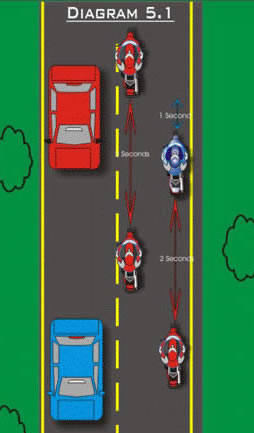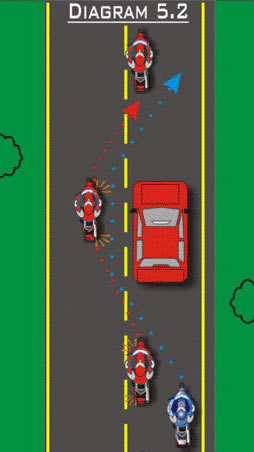Group motorcycle riding
Riding a motorcycle is a great deal of fun, but it is a lot more fun when you have a few friends to ride with. Riding in a group does however have its own set of challenges. The first is communication. Anyone who has ridden in a group knows that it is difficult to talk to other riders while you are riding, unless everyone has an Intercom system. Although an intercom system is probably the best form of on bike communication, not every rider has one (due to affordability or practicality issues). Therefore it is important that the riders in a group have a set of basic hand signals so that they can communicate effectively while they are on the road. Each group should have at least a basic set of signals that can easily convey issues ranging from the need to stop (gas, restroom/ rest break, and bike problems) to warnings (police, debris/ road hazards, and direction changes).
Another problem while riding in a relatively large group (approximately 6 or more riders) is keeping the group together. Things such stop lights/ stop signs and other vehicles on the road tend to create chaos for the cohesive nature of a group. There will be instances when a group may be broken up into smaller groups:
- Only a portion of the group makes it through a light before it changes
- Turning at an intersection allows other vehicles to divide the group
- Not all riders can pass a vehicle(s) safely
- Mechanical problem/ rider falls at the middle or near the back of the group
What can the Leader(s) of the group do to keep this from happening? There are a few things that the riders can do to keep their group together as well as make their ride safer. As the lead rider approaches a light that is about to change, he/she has a few options:
- If there is enough space & time and it is safe to do so, slowdown and let the light change before the group arrives
- Pull over after passing the light or slow down so that the rest of the group can catch up without having to do excessive speeds
When passing slower traffic:
- Do not pass until there is enough room for all riders to pass (if the group is relatively small)
- After passing a vehicle, make enough room for the riders behind you. You don’t want to stand another rider in “no man’s land” (the wrong side of the yellow line) with oncoming traffic
The most important thing that a group can do to make their ride more enjoyable and safer is to be organized. The entire group should know the destination of the ride, as well as the route being taken. Also there should be designated rest stop as well as meeting spots in case the group does get separated. What this does is take pressure of riders who are separated from the rest of the group. Riders will be less inclined to ride over their heads in an effort to try and catch up/ keep up with the group, if they know that everyone will be waiting for them at a certain gas station, restaurant etc up the road. This is particularly true of newer riders, who might be uncomfortable with the pace set by more experienced riders in the group. Cell phones are also a good idea in case of an emergency (fall, mechanical failure, etc); the rest of the group can be contacted and kept apprised of the situation.
When riding in a group the riders should ride in what is called “Staggered Formation”, diagram 5.1 depicts this staggered formation in action. As we can see the leader is in the left portion of the lane (blocking position). The next rider is 1 second behind the leader, in the right portion of the lane. The third rider is in the left portion of the lane, 2 seconds behind the leader and 1 second behind the second rider. And the forth rider is 2 seconds behind the second rider.

The easiest way to judge following distance is by using time. While following a vehicle, choose a stationary object up ahead (a tree, sign, light standard, etc). As the vehicle in front of you passes the object, start counting until you pass the same object. Ideally you want a minimum of two seconds between you and the rider directly in front of you.
Note: The lead rider should always assume the blocking position for the lane that the group is riding in, when the group changes lanes then the leader should again assume the blocking position and the other riders stagger themselves accordingly.
This “Staggered Formation” provides safety for a group in two ways:
- Size – the group is more compact, you can imagine how long this group of 4 riders would be if they were riding single file. The last rider would be off the diagram. Also the more spread out a group is the more it invites car drivers to attempt to merge between riders
- Space – every rider in the group has a safety cushion around him/ her, 2 seconds in front and behind as well as room to manoeuvre from side to side to avoid debris, potholes etc.
Note: There will be situations when it will be safer for the group to use the single file formation. These would include:
- Turns
- On/Off Ramps
- Streetcar tracks
- Passing slower vehicles
- Construction Zones
- Narrow Bridges
- Roads with parked cars

When passing slower vehicles (diagram 5.2), each rider should spend as little time as possible in “no man’s land”. The group should not try to pass together. If something were to happen some riders could be caught on the wrong side of the yellow line, with on-coming traffic rapidly approaching.
The LeaderIn every group there is a leader, but what makes a good leader? Does the rider with the most experience make the best leader? Not necessarily! Just because a rider has a high level of skill doesn’t mean that he/ she will make a good leader. “Good skills are irrelevant in the absence of good judgment!” To be a leader a rider must be able to set a pace that every one in the group can follow safely. He or she must also be able to plan ahead and communicate to the other members of the group. Making last minute turns, stops, lane changes, etc will catch other riders off guard and can lead to disaster.
If you are a leader who constantly loses slower riders in the group, you are not doing a good job of leading. A good leader also has to be able to follow others as well. “If you cannot follow others, how do you expect others to follow you?”
Chase RiderAs well as having a leader, a group should also have a chase rider, the last rider in the group. This rider’s duty is to keep an eye on the riders in front of him/ her. This should also be a rider with a fair amount of experience. If something were to happen (a fall, mechanical failure, etc) to a rider near the back of the group, the chase rider will be there to deal with the situation.
One of the biggest problems with riding in a group is that speeds can get out of hand quickly. Normally the ride starts off at legal speeds, then one rider ups the pace a little, and then the next rider will up the ante. Before you know it the group is doing speeds well above the legal limit. How do you keep this from happening? The best way to that I can suggest to keep this from happening is to ride with people that you know and trust. Personally if I ride with someone for the first time and they do something that put others at risk I will not ride with that person again period! I have better things to do than scrape someone off the road.
“Riding in a group is not about competing with each other; it’s about working together as a unit. If you want to compete go to the track!”





